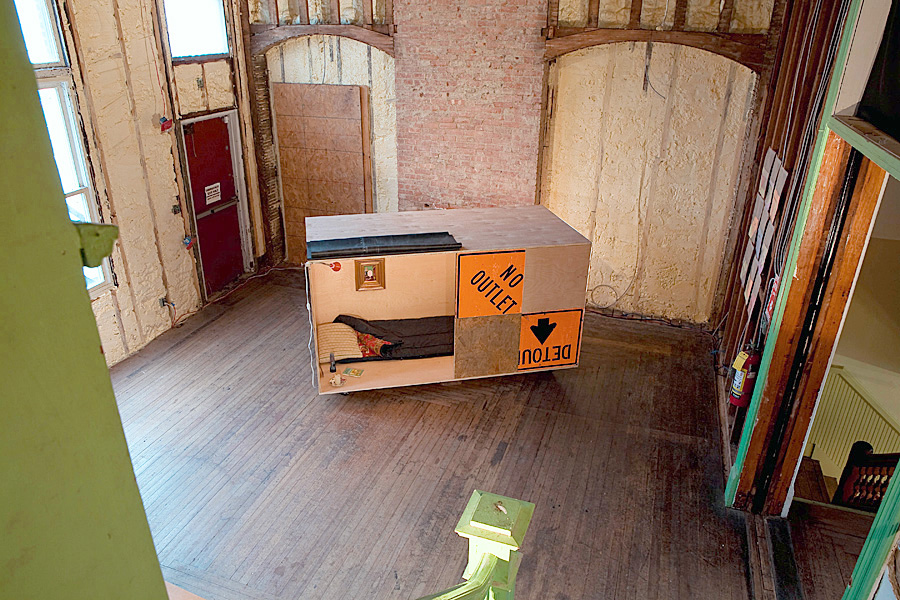 While policymakers — backed by real estate developers, the development industry, and the pressures of global capitalism — are pushing slum redevelopment models that replace informal settlements with high-rise blocks, some urban practitioners are using slums as models for redeveloping decaying neighborhoods in the West.
While policymakers — backed by real estate developers, the development industry, and the pressures of global capitalism — are pushing slum redevelopment models that replace informal settlements with high-rise blocks, some urban practitioners are using slums as models for redeveloping decaying neighborhoods in the West.Architect Teddy Cruz drew on design elements he observed in the shantytowns of Tijuana to inform a redevelopment plan aimed at reintegrating poor immigrants into the fabric of a gentrifying town in Hudson River Valley. He previously incorporated Tijuana's lessons into a design for a residential complex for Latino immigrants near San Diego.
Cruz is one
 of a growing number of architects and other professionals looking to informal settlements for lessons on good urban design. These practitioners point out that, for all their deprivations, slums exemplify many of the textbook qualities that make up strong urban environments: low-rise, high-density, mixed use. They are home to well-functioning public spaces, heterogeneous communities and aesthetically interesting spaces. They promote safety by channeling "eyes on the street."
of a growing number of architects and other professionals looking to informal settlements for lessons on good urban design. These practitioners point out that, for all their deprivations, slums exemplify many of the textbook qualities that make up strong urban environments: low-rise, high-density, mixed use. They are home to well-functioning public spaces, heterogeneous communities and aesthetically interesting spaces. They promote safety by channeling "eyes on the street."In an age where sustainability is the keyword, slums are "green" in their efficient use and reuse of materials for construction and livelihood activities. They are highly walkable, often represent optimal utilization of space and are easily adaptable to changing user needs.
Some have also argued that the decentralized, informal production pr
 ocesses and blending of live-work spaces that slum typologies allow represent a restructuring in line with the demands of a post-industrial economy.
ocesses and blending of live-work spaces that slum typologies allow represent a restructuring in line with the demands of a post-industrial economy.In February, no less than Prince Charles lauded Dharavi — a vast slum in central Mumbai that he visited in 2003 and has since become the focus of a multi-billion dollar redevelopment plan — as a healthy antidote to built environments created through a "brutal and insensitive process of globalisation." He suggested that "it may be the case that in a few years’ time such communities [as Dharavi] will be perceived as best equipped to face the challenges that confront us because they have a built-in resilience and genuinely durable ways of living.”
It seems that slums are the new utopian landscapes — and they couldn't be more different than the neat segmentation and uniformity of the previous generation's suburban and modernist dreams.
While the West is trying to recapture something lost, many slum inhabitants can't wait to get out. Slum residents who are relatively wealthy, better educated and young and who live in well-developed slums in cities where building-living is the norm (which are also the ones that designers are emulating) often strive for the privacy, social mobility and security that high-rise buildings connote. On one hand, you can argue that their face-value aspirations are unreliable because they have not been presented with another version of what it means to be modern, middle-class and legal. But all of our preferences and judgments are similarly socially conditioned. Is this a case of "you don't miss it 'till it's gone"? Or is the grass always greener?

Equally eager to leave slum settlements are those on the other side of the spectrum from Dharavi, where there is no public space to speak of, no more than half of the family fits in the house at a time, and you risk getting hit by a train or falling off a water pipe when you go outside. Although such places remind us of people's capacity for ingenuity and survival and can be aesthetically interesting, no one actually wants to live here.
There are many places in between, and overall, I would guess most inhabitants of slums would prefer to preserve their current settlements and stay in ground-floor structures that they can increment over time. And there's a lot to learn from these well-functioning, organic neighborhoods.
Those who use "slum" as a blanket term to connote blight and justify self-serving solutions ignore the diversity among slums and the strengths that many already possess. However, those admiring the forms of certain types of slums should also not glaze over the diversity of slum environments — as well as the people who live in them — to make their point. Let's hope that this wave of excitement about "slumchitecture" does not lead to superficial conclusions, but rather that it energizes debates and generates perspectives that can create better cities in both proverbial hemispheres.
(Photos by Katia Savchuk. Image of Teddy Cruz's model from the New York Times.)







